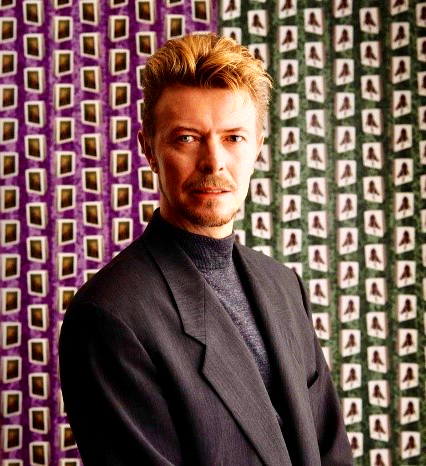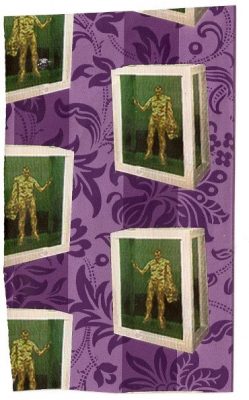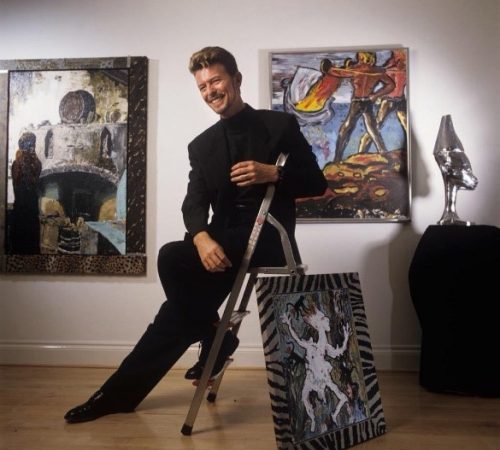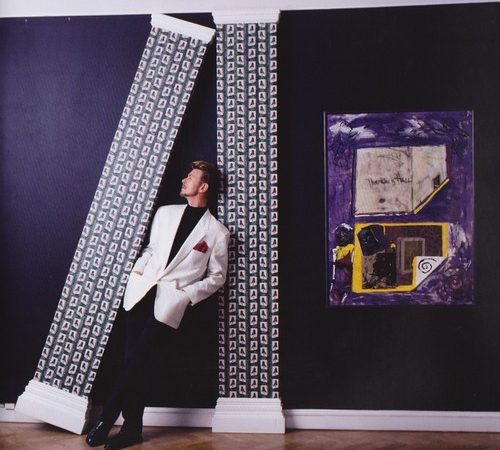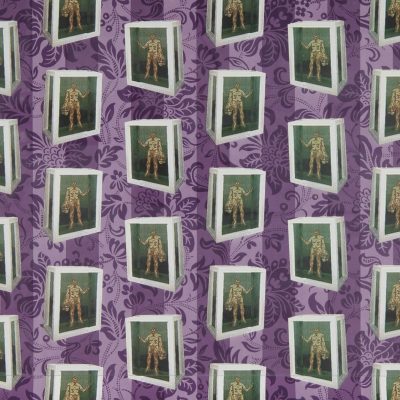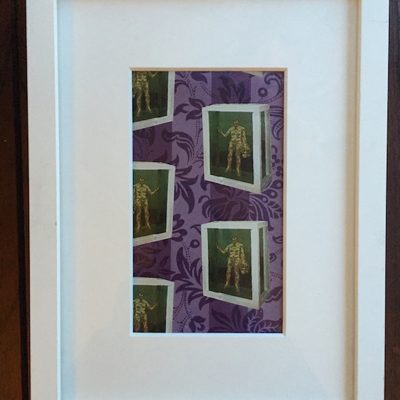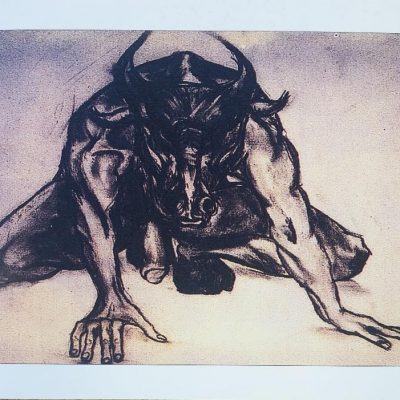DAVID BOWIE
STAGING WALLPAPER
Paul Maréchal, May 1st, 2020.
A global icon of pop music and a transgressor of the codes attributed to genres, David Bowie (1947-2016) was also an actor and a painter, a lesser known aspect of his talents. Initiator of musical currents such as glam rock and plastic soul in the early the 1970s, Bowie then practiced painting, which he further explored during his stay in Berlin between 1976 and 1978. It was through painting, music and reading that he tried to overcome a strong cocaine addiction.
Since the 1970s, the artist has always devoted an important part of his intellectual activity to painting, both through his practice and his purchases of works of art. These acquisitions have proved to constitute an impressive collection of paintings dispersed in a public auction at Sotheby’s New York on November 10 and 11, 2016. Bowie revealed his talents in the visual arts, even though he did not benefit from a solid technical training, by creating two wallpapers that he displayed in the very first exhibition of his works. Entitled New Afro/Pagan and Work 1975-1995 (Fig.5), it was first presented from April 18-29, 1995 at The Gallery, 28 Cork Street, London, in the chic Mayfair district. These two wallpapers, dated from 1995, are the only ones he ever produced. He had integrated them into the above-mentioned exhibition in order to create an installation, a work in situ.
Bowie explained his decision to use wallpaper as follows: “I chose wallpaper because of its status as something incongruous, particularly in the world of art. I haven’t completely lost my sense of irony, you know!”. Bowie then set out to find a printer to produce his work, noting in passing that “it’s hard to get wallpaper printed”[1]. The prestigious English decoration firm Laura Ashley (1925-1985), whose workshop is still located in Wales today, offered to have them printed.
For the first paper, Conflict (Fig.2), he called upon the collaboration of two of the most important British artists of the time, Lucian Freud (1922-2011) and Damian Hirst (born in 1965). Freud provides his nude self-portrait from the previous year (1994) and Hirst a case reminiscent of the boxes he used at the time and in which he immersed animals. Bowie framed Freud’s self-portrait in Hirst’s box and set it against a purplish floral background. This motif was chosen by Bowie himself from a selection provided to him by the firm Laura Ashley. For Bowie, this wallpaper was intended to illustrate the opposition between traditional and contemporary art, hence its title Conflict. The result is “… traditional art in the hands of modern art”[2] according to Bowie who succeeded in bringing together four of the most important British visual artists of the late twentieth century. Bowie, who regularly visited Hirst at his studio and with whom he painted jointly (Fig.8), confided even more about his achievement in his last biography, stating that “Hanging wallpaper isn’t my kind of thing, but I could definitely art direct, and I could light it beautifully. I could tell other people to hang it, believe you me”[3].
The second wallpaper, The Minotaur (Fig.3), was intended to adorn two classical-style half-columns leaning against a wall in the exhibition hall. A photo by famous English photographer Lord Snowdon, captures Bowie posing in front of them (Fig.4), immortalized this installation. The creation of The Minotaur was not without pitfalls for Bowie. The motif was based on one of his charcoal drawings, The Crouch, which was exhibited elsewhere in the gallery, and showed a crouching minotaur with a large penis that Laura Ashley’s people censored, informing Bowie that they could not print such an image. Bowie castrated his minotaur without holding it against Laura Ashley’s collaborators: “It’s been a good working relationship, apart from the castration, that is!”.
Only seven rolls of 11 meters each of these two wallpapers were printed, contrary to the erroneous information circulating in the press announcing that David Bowie had created a line of wallpaper for the famous firm. Jacqui Moore, who was Laura Ashley’s communications manager from 1993 to 1998, oversaw the project after being approached by Bowie’s London curator, Kate Chertavian.
(Left: Fig.4) David Bowie with his wallpapers, during the exhibit David Bowie: New Afro/Pagan and Work 1975-1995, at The Gallery, Cork Street, London, 1995. Photo: Lord Snowdon.
(Right: Fig.5) Bowie during the exhibit David Bowie: New Afro/Pagan and Work 1975-1995, at The Gallery, Cork Street, London, 1995. Photo: Lord Snowdon.
At the end of the exhibition, in late April 1995, Brian Eno, the legendary producer of Bowie’s albums including the famous Berlin trilogy Low (1977), Heroes (1977) and Lodger (1979), as well as the famous Outside (1995), Bowie’s latest opus at the time, had the idea of cutting part of the wallpaper into pieces to be used for a benefit event he called War Child. For this project, he designed a white box, issued in 500 copies (Fig.6), in which were placed a piece of the wallpaper; a copy of the Antannae # 1 soundtrack specifically created for the event produced by Eno; a photo by Anton Corbijn and a watercolour by Patrick Hughes. The boxes were sold at the War Child’s Pagan Fun Wear benefit fashion gala held at the prestigious Saatchi Gallery, in London’s chic district St John’s Wood. The fashion gala featured diverse creations such as a weird leather tie by Lou Reed, some strange shoes by Jarvis Cocker and a suit of bandages designed by Bowie himself.
(Left: Fig.7) Bowie explaining his wallpaper during an interview on a Dutch TV show. Source https://youtu.be/Lt7FrufzaPU?t=471
(Right: Fig.6) A box issued for the War Child benefit, organized by Brian Eno, which contains Bowie’s wallpaper.
One of the technicians’ testimony on the process of making the two wallpapers is indicative of the difficulties encountered when printing the wallpapers the way Bowie had requested. Mr. Dan Smout, one of the technicians in Laura Ashley’s workshop who worked on that project, testified: “I worked for Laura Ashley for a number of years in gravure press printing wallpaper. Everyone called it the bomb factory because the printing process involved volatile chemicals. So if there was an explosion, the roof would have come off! Minimizing the damage caused by possible explosions was a constant concern. When Laura Ashley was sold to other investors, they discovered how to secure the printing process and moved the press to where the textile factory was located. I left the workshop just as they were moving the presses. The wallpaper patterns were printed from seven engraved and chrome-plated copper cylinders each (for a total of 14 cylinders) that were engraved and then hard chromed, which was quite expensive. I don’t know what happened to the cylinders after. They were not kept in Laura Ashley’s workshop with the other cylinder designs, so they must have been recycled or given to David Bowie, which I doubt because there are big and heavy”[4].
For Bowie, the integration of his wallpapers to his painting exhibition essentially allowed him to present his work as a whole. Experienced in the performing arts, which includes skillful lighting, studied sets, choreography, mime and many other aspects found in his shows, Bowie wanted to stage his paintings by choosing to create the wallpaper and lighting for the exhibition himself. The exhibition then became an installation, an event, in the manner of his musical performances, but this time it was the colour and motifs of his paintings that became the performers.
Notes
1. https://blog.lauraashley.com/archive-laura-ashley-blog/david-bowie-lucian-freud-wallpaper/
2. Ibid.
3. Bowie: The Biography by Wendy Leigh, Simon and Schuster, N.Y., 2014, page 245.
4. Remarks collected by Paul Maréchal in July 2019.
PAUL MARÉCHAL
About the author
Montreal native Paul Maréchal is an art historian and the curator of the Power Corporation of Canada collection since 1993. After his undergraduate studies in Cinema and Production at Concordia University in 1988, he pursued a master’s in art history at Université du Québec à Montréal in 1994, where he has taught the course on the art market since 1997.
Paul Maréchal has undertaken extensive studies of Andy Warhol’s work. He is the author of four catalogues raisonnés on the artist’s graphic work. A first survey of all 65 record covers was published by Prestel (Random House’s Art & Architecture subsidiary) in 2008, reissued in 2015. This work served as the basis for the Warhol Live exhibition at the Montreal Museum of Fine Arts in 2008.
In 2014, two additional studies are published by Prestel: the first covered the artist’s 40 advertising posters and the second covered the 425 illustrations and magazine covers commissioned by more than 60 publishers. These publications have been the basis for several exhibitions on these subjects in museums in London, Barcelona, Madrid and Lyon, among others.
Translation by Dominique Robb.
DAVID BOWIE
Conflict (Portrait of Lucian Freud), 1995
Wallpaper printed in colors
Roll overall: 535 mm x 57 mm (21 in x 2¼ in)
Printed by Laura Ashley
The Minotaur, 1995
Wallpaper printed in colors
Roll overall: 535 mm x 57 mm (21 in x 2¼ in)
Printed by Laura Ashley
CURATOR
CLAUDE GOSSELIN, C.M. (c.v.)
General and Artistic Director
Centre international d’art contemporain de Montréal
claude.gosselin@ciac.ca
ASSISTANT CURATOR
VINCENT GODIN-FILION
General and Artistic Direction Assistant
Centre international d’art contemporain de Montréal
vincent.godin-filion@ciac.ca



